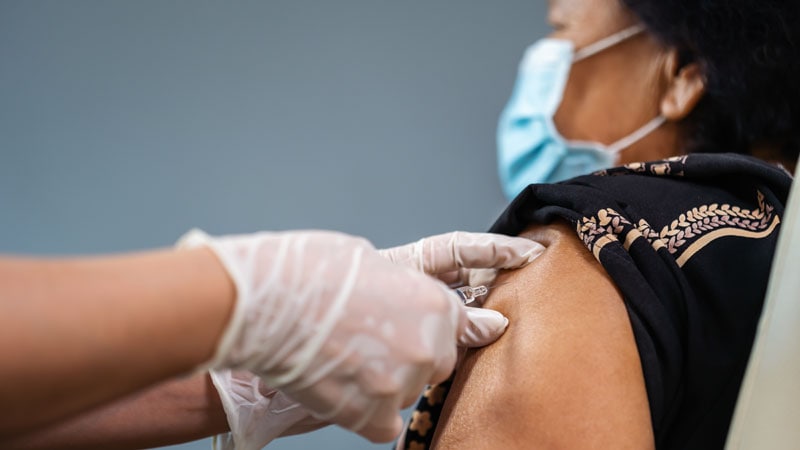Editor’s note: Find the latest COVID-19 news and guidance in Medscape’s Coronavirus Resource Center.
WASHINGTON, DC ― The updated Moderna bivalent COVID-19 vaccine that targets the original virus and the Omicron variant was superior to the original COVID booster in adults aged 18 and older, new results indicate.
The bivalent booster was superior regardless of age and whether a person had previously been infected with SARS-CoV-2.
Additionally, no new safety concerns emerged.
Spyros Chalkias, MD, senior medical director of clinical development at Moderna, presented the data on Thursday at the Infectious Disease Week (IDWeek) 2022 Annual Meeting.
In the phase 2/3 trial, participants sreceived either 50 µg of the bivalent vaccine mRNA-1273.214 (25 µg each of the original Wuhan-Hu-1 and Omicron BA.1 spike mRNAs) or 50 µg of the standard authorized mRNA-1273. The doses were given as second boosters in adults who had previously received a two-dose primary series and a first booster at least 3 months before.
The model-based geometric mean titers (GMTs) ratio of the enhanced booster compared to the standard booster was 1.74 (1.49 − 2.04), meeting the prespecified bar for superiority against Omicron BA.1.
In participants without prior SARS-CoV-2 infection who received updated booster doses and those who received standard boosters, the neutralizing antibody GMTs against Omicron BA.1 were 2372.4 and 1473.5, respectively.
Additionally, the updated booster elicited higher GMTs (727.4) than the standard booster (492.1) against Omicron subvariants BA.4/BA.5. Safety and reactogenicity were similar for both vaccine groups.
“By the end of this year, we expect to also have clinical trial data from our BA.4/BA.5 bivalent booster,” Chalkias said.
In the interim, last week, the US Food and Drug Administration granted emergency use authorization for Moderna’s BA.4/BA.5 Omicron-targeting bivalent COVID-19 booster vaccine in children and adolescents aged 6 – 17 years.
Also last week, Pfizer/BioNTech issued an announcement that their COVID-19 booster, adapted for the BA.4 and the BA.5 Omicron subvariants, generated a strong immune response and was well tolerated in human tests,
Pfizer/BioNTech said data from roughly 80 adult patients showed that the booster led to a substantial increase in neutralizing antibody levels against the BA.4/BA.5 variants after 1 week.
Separate Study of Causes of Severe Breakthrough Infections in Early Vaccine Formulations
Though COVID vaccines reduce the incidence of severe outcomes, there are reports of breakthrough infections in persons who received the original vaccines, and some of these have been serious.
In a separate study, also presented Thursday, researchers led by first author Austin D. Vo, BS, with the VA Boston Healthcare System, used data collected from December 15, 2020, through February 28, 2022, in a US veteran population to assess those at highest risk for severe disease despite vaccination.
Results of the large, nationwide retrospective study were simultaneously published Thursday in JAMA Network Open.
The primary outcome was development of severe COVID, defined as a hospitalization within 14 days of a confirmed positive SARS-CoV-2 test, receipt of supplemental oxygen, mechanical ventilation, or death within 28 days.
Among 110,760 participants with severe disease after primary vaccination, 13% (14,690) were hospitalized with severe COVID-19 or died.
The strongest risk factor for severe disease despite vaccination was age, the researchers found.
Presenting author Westyn Branch-Elliman, MD, associate professor of medicine with VA Boston Healthcare System in Massachusetts, said, “We found that age greater than 50 was associated with an adjusted odds ratio of 1.42 for every 5-year increase.”
To put that in perspective, she said, “compared to patients who are 45 to 50, those over 80 had an adjusted odds ratio of 16 for hospitalization or death following breakthrough infection.”
Priya Nori, MD, an infectious disease specialist at Montefiore Medical Center in New York City, told Medscape Medical News that the evidence that age is a strong risk factor for severe disease ― even after vaccination ― confirms that attention should be focused on those in the highest age groups, particularly those 80 years and older.
Other top risk factors included having immunocompromising conditions; having received cytotoxic chemotherapy within 6 months (adjusted odds ratio [aOR], 2.69; 95% CI, 2.25 – 3.21); having leukemias/lymphomas (aOR, 1.84, 95% CI, 1.59 – 2.14); and having chronic conditions associated with end-organ disease.
“We also found that receipt of an additional booster dose of vaccine was associated with a 50% reduction in adjusted odds of severe disease,” noted Branch-Elliman
Nori emphasized that, given these data, emphatic messaging is needed to encourage uptake of the updated Omicron-targeted vaccines for these high-risk age groups.
The study by Chalkias and colleagues was funded by Moderna. Chalkias and several co-authors are employed by Moderna. One co-author has relationships with DLA Piper, LLC/Medtronic, and Gilead Pharmaceuticals, and one has relationships with Celgene/Bristol-Myers Squibb, ChemoCentryx, Gilead, and Kiniksa. Nori has disclosed no relevant financial relationships.
JAMA Netw Open. Published October 20, 2022. Full text
Infectious Disease Week (IDWeek) 2022 Annual Meeting: Abstracts LB750 and 788. Presented October 20, 2022.
Marcia Frellick is a freelance journalist based in Chicago. She has previously written for the Chicago Tribune, Science News, and Nurse.com, and was an editor at the Chicago Sun-Times, the Cincinnati Enquirer, and the St. Cloud (Minnesota) Times. Follow her on Twitter at @mfrellick
For more news, follow Medscape on Facebook, Twitter, Instagram, and YouTube.
Source: Read Full Article
